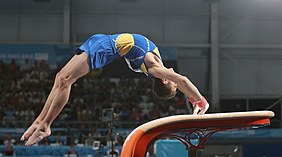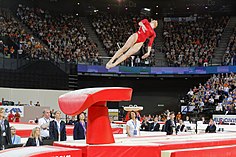The gymnastic system was mentioned in writings by ancient authors, such as Homer, Aristotle, and Plato. It included many disciplines that later became independent sports, such as swimming, racing, wrestling, boxing, and riding,[1] and was also used for military training. In its present form, gymnastics evolved in Bohemia and what is now Germany at the beginning of the 19th century, and the term "artistic gymnastics" was introduced at the same time to distinguish free styles from those used by the military.[2] The German educator Friedrich Ludwig Jahn, who was known as the father of gymnastics,[3] invented several apparatuses, including the horizontal bar and parallel bars, that are used to this day.[4] Two of the first gymnastics clubs were Turnvereins and Sokols.
- Vault
- The vault is an event as well as the primary piece of equipment used in that event. Unlike most of the gymnastic events employing apparatuses, the vault is common to both men's and women's competition, with little difference between the two categories. A gymnast sprints down a runway, which is a maximum of 25 m (82 ft) in length, before leaping onto a springboard. Harnessing the energy of the spring, the gymnast directs his or her body hands-first towards the vault. Body position is maintained while "popping" (blocking using only a shoulder movement) the vaulting platform. The gymnast then rotates his or her body to land in a standing position on the far side of the vault. In advanced gymnastics, multiple twists and somersaults may be added before landing. Successful vaults depend on the speed of the run, the length of the hurdle, the power the gymnast generates from the legs and shoulder girdle, kinesthetic awareness in the air, and the speed of rotation in the case of more difficult and complex vaults.
- In 2004, the traditional vaulting horse was replaced with a new apparatus, sometimes known as a tongue, table, or pegasus. The name pegasus was given because it was first introduced during the 2004 summer Olympics in Athens, Greece. It is more stable, wider, and longer than the older vaulting horse—about 1 m (3.3 ft) in length and width—giving gymnasts a larger blocking surface, and is therefore safer than the old vaulting horse. With the addition of this new and safer apparatus, gymnasts are attempting more difficult and dangerous vaults.
![]() Diego Hypólito (BRA) vaulting from a modern vaulting table during the 2007 Pan American Games
Diego Hypólito (BRA) vaulting from a modern vaulting table during the 2007 Pan American Games
![]() Nazar Chepurnyi (UKR) vaulting at the 2018 Youth Olympic Games
Nazar Chepurnyi (UKR) vaulting at the 2018 Youth Olympic Games
![]() Ksenia Afanasyeva (RUS) vaulting at the 2015 European Championships
Ksenia Afanasyeva (RUS) vaulting at the 2015 European Championships



